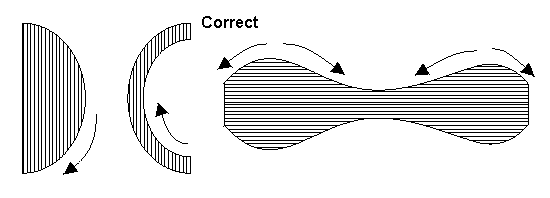| Main page | Læs denne side på dansk |

|
Turning with or against the wood
 All woodturners have experienced that the grain is torn in some areas on the turned object. Of course, this can't fully be avoideed but you can do a lot to minimise the problem. The most important is to use sharp tools, to use the right cutting technique and to cut with the grain of the wood.
All woodturners have experienced that the grain is torn in some areas on the turned object. Of course, this can't fully be avoideed but you can do a lot to minimise the problem. The most important is to use sharp tools, to use the right cutting technique and to cut with the grain of the wood.
What cutting with the grain is, is best understood if you remember that wood is comprised of strong fibres and that the fibres are not as strong interconnected with each other.
On a surface where the fibres have been cut, it makes a difference whether you cut in the one or in the other direction. If you as shown in the illustration to the right are cutting so that the fibres are pointing towards the tool, the tool will have a tendency to dig inbetween the fibres and tear the fibres apart. Then it is more likely that the tool will tear the grain than cut it.
If the tool cuts in the same direction as the fibres are pointing, the tool will press the fibres against the fibres below so that the fibres are supported and the risk of tearing the fibres apart is minimal. There isn't a risk that the tool will dig inbetween the fibres.
Therefore, you should turn so that the tool on a surface with cut fibres cuts in the direction the fibres are pointing as shown below.
To obtain this when faceplate turning (with the fibres perpendicular to the turning axis of the lathe) as shown to the left below, you 1) have to cut 1) from the outer bottom of a bowl towards the rim of a bowl or 2) from the rim of the bowl to the inner bottom of the bowl. When faceplate turning, it isn't possible to fully cut in the correct direction as the fibres go in opposite directions on the opposite sides of the wood.
When spindle turning (with the fibres parallel to the turning axis of the lathe) as shown to the right below, it is possible to fully cut with the fibres by always cutting from the highest (thickest) part towards the lowest (thinnest) part. That means that you can't cut into a cove/hollow and up on the other side. You have to cut down from each side towards the bottom of the cove.
Jars, boxes, vases etc. turned with the fibres parallel to the lathe axis and cut from the end of the wood should theoretically be hollowed from the bottom and up. However, this isn't practical, so in most cases you will here turn against the fibres (a hook tool can turn from the bottom and up). On the outside they are turned as ordinary spindle turning from the highest towards the lowest point.

However, as with the hollowing of boxes, it isn't absolutely necessary to cut with the grain, especially in green (fresh) wood. Sometimes, it isn't possible to cut with the grain, sometimes it is just easier to turn in the other direction. When you get a feelling of the wood, you will also have a feeling of how important it is to cut with the grain. Or you can simple try cutting against the wood to make a test. If you have to cut against the wood and there is a tendency to torn fibre, use a very sharp tool an take very gentle cuts.
If you are cutting parallel to the grain, as on a flat plate for a cutting board, the direction of the cut doesn't matter. The same is the case if the cut is perpendicular to the grain as when turning across the end grain on the buttom of a box.
| Search this site: |